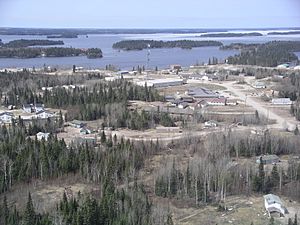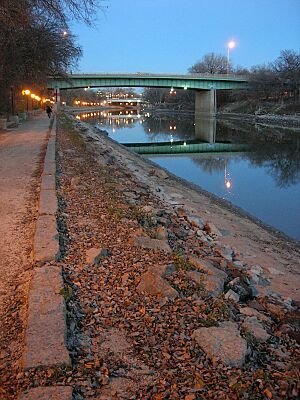Rinelle Harper facts for kids
Quick facts for kids
Rinelle Harper
|
|
|---|---|
| Born | 1998 (age 27–28) |
| Nationality | Canadian |
| Known for | Advocating for national inquiry into missing and murdered indigenous women |
Rinelle Harper was born in 1998. She is a Canadian woman from the Garden Hill First Nation in Manitoba. In 2014, when she was 16, Rinelle survived a very difficult experience. After this, she became well-known for speaking up for others who have faced violence. She asked for a special investigation into missing and murdered Indigenous women in Canada. She spoke to important groups like the Assembly of First Nations. She also spoke at the first Canadian meeting about this important topic.
Contents
Rinelle's Early Life

Rinelle Harper is a member of the Garden Hill First Nation in Manitoba. She has two siblings. Her parents are Julie and Caesar Harper. Her uncle was Elijah Harper, a politician who was known for not agreeing with some big changes to Canada's laws in 1990.
When she was a teenager, Rinelle went to Southeast Collegiate. This is a high school in Winnipeg for Indigenous students. It is run by several First Nations communities. Rinelle speaks both English and Oji-Cree fluently.
A Difficult Time in 2014

In November 2014, Rinelle Harper was 16 years old. She was in Winnipeg with friends, celebrating finishing their mid-term exams. Late that night, Rinelle got separated from her friends. She was approached by two young men. Later, she was found by two construction workers. They called for help and kept her warm. Rinelle was taken to the hospital. She was in serious condition but thankfully survived and slowly got better.
Speaking Up for Change
The Royal Canadian Mounted Police (RCMP) have reported that Indigenous women are much more likely to be missing or murdered in Canada. Rinelle's experience happened not long after another young First Nations woman, Tina Fontaine, went missing and her body was found. Rinelle's story helped start new talks across Canada about violence against Indigenous women. It made people push harder for the government to start an investigation into missing and murdered Indigenous women.
In December 2014, Rinelle spoke to over 3000 people at the Assembly of First Nations. She talked about stopping violence against young women. She asked everyone there to demand a national investigation.
For many months, the Prime Minister at the time, Stephen Harper, did not agree to an investigation. He said that cases of missing and murdered Indigenous women were sad, but did not need more study. He said that these attacks were often started by Indigenous men and local police could handle them. However, the national Liberal Party and New Democratic Party both promised to start a public investigation if they won the election in October 2015.
In November 2015, Rinelle Harper spoke at a special event in Alberta. This event was part of the first national Canadian meeting about missing and murdered Indigenous women.
Recovery and Advocacy
After her attack, Rinelle met and became friends with Amanda Lindhout. Amanda is a Canadian journalist who had also gone through a very difficult experience. She was able to share her story and help Rinelle deal with what happened.
On July 17, 2015, Rinelle's family home in the Garden Hill First Nation burned down. The family was in Winnipeg at the time because Rinelle was having surgery for injuries from her attack. No one was hurt in the fire, but the family lost most of their belongings. After people heard about what happened, many online fundraising campaigns were started to help the Harpers. Amanda Lindhout also helped with one of these campaigns.
After the fire, Rinelle and her family moved to Winnipeg for good. Rinelle wanted to go back to Southeast Collegiate for her last year of high school. But the school told her she could no longer attend. Southeast Collegiate only accepts Indigenous students from remote communities. Since the Harpers no longer had a home in the Garden Hill First Nation, they did not meet the rules. Rinelle was put on a waiting list for another school.
Even though she is shy, Rinelle has said she wants to be "a voice for the voiceless." In November 2015, she spoke at a We Day event in Winnipeg. She talked to thousands of young people about how education can empower them. She also shared her own story of recovering from violence. That same year, she started working on a book with Canadian author Maggie de Vries. The book is called A Voice for Change.
Rinelle has said she wants to become a phys-ed teacher or a doctor someday.
Images for kids
-
The Assiniboine River in Winnipeg, Manitoba


